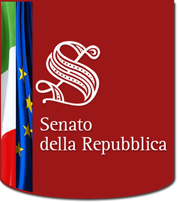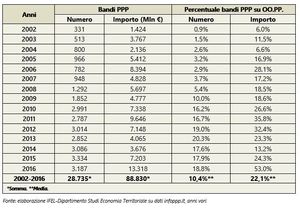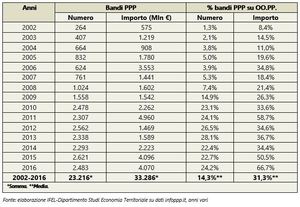Partner cercasi (a scopo investimento). Dove, come, quanto funziona in Italia il partenariato tra pubblico e privato?

L'Italia, pur presentando nel 2016 un'elevata incidenza della spesa pubblica sul PIL (49,6%), destina agli investimenti una parte molto modesta delle proprie risorse: un 2,1% che non basta a sostenere tutti gli investimenti, specialmente quelli infrastrutturali, di cui il Paese ha una gran fame per sostenere la domanda aggregata, ampliare i livelli di servizio, ridurre i divari economici territoriali, recuperare competitività.
Per le amministrazioni pubbliche, e in particolare i comuni italiani, il partenariato pubblico-privato (PPP) ha rappresentato perciò, negli ultimi 15 anni, una risorsa sempre più importante per finanziare la realizzazione di nuove infrastrutture (metropolitane, campi sportivi, reti per le telecomunicazioni) e la fornitura di servizi (dalla gestione dei rifiuti alla pulizia delle strade).
Passato da poco più di 300 bandi nel 2002 agli oltre 3.000 del 2016, il PPP ha mosso finora oltre 88 miliardi di euro in tutto il paese. Ma i lunghi tempi della burocrazia, le carenze tecnico-progettuali e le criticità gestionali possono mettere a rischio i risultati: su 33.164 procedimenti attivati tra 2002 e 2016, 4.429 (poco meno del 13%) risultano interrotti. E la mortalità sale al 42% sulle grandi opere PPP - oltre i 50 milioni di euro - attivate dalle pubbliche amministrazioni italiane tra 2002 e 2014.
Partners wanted (for investments). Where, how and how much does the public-private partnership in Italy work?
Italy's public spending accounted for a good 49.6% of GDP in 2016, but it allocated a very modest share of its resources to investments: just 2.1%, which is not enough to support all investments - especially infrastructure projects - which the country so much needs in order to support aggregate demand, improve and expand service levels, narrow the geographical economic divides and boost competitiveness.
For public administrations, especially Italian municipalities, the public-private partnership (PPP) has therefore been, over the past 15 years, a very important resource for financing new infrastructure projects (underground rail, sports facilities, TLC networks) and for providing services (from waste disposal services to street cleaning).
Calls for bids in the PPP sphere have soared from just over 300 in 2002 to over 3,000 in 2016, meaning that the PPP turnover has exceeded 88 billion Euros so far. But lengthy bureaucracy, technical/planning shortfalls and management issues are jeopardising the results: of the 33,164 procedures activated in Italy from 2002 to 2016, 4,429 (almost 13%) have been interrupted. And the percentage is even greater for major works worth more than 50 million Euros set up as PPPs by public administrations: 42% between 2002 and 2014.







 Focus
Focus